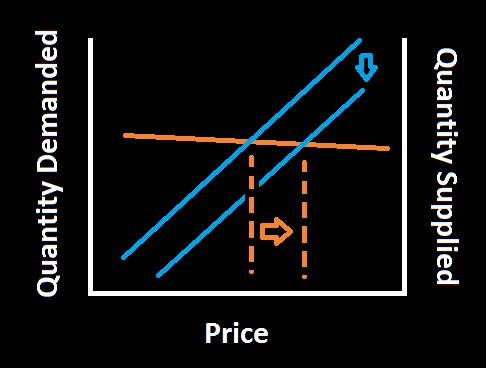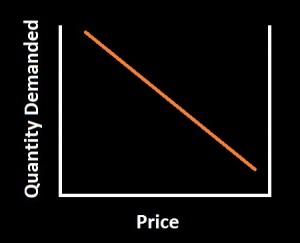I don’t suppose the interweb needs another discussion of the failings of market forces in health care markets. And yet the idea persists that setting the price of health care should be left to the unregulated market and that this will lead to maximum efficiency. The omnipotence of the market is a comforting concept.
Demand-side troubles
But the market for anti-retroviral drugs bears little resemblance to golf clubs or top sirloin. At risk of sounding condescending, a typical demand curve looks like this
As the price of a good or service rises, the quantity demanded shrinks. Lots of people will buy a pair of basketball shoes for $6. A few would pay $140.
But this doesn’t often work for medical services. I recently had my appendix removed. I’m told a typical appendectomy costs $25,000–a lot of money no matter who you are. But whether it had cost $100 or $100,000, I still would have bought exactly one appendectomy. The demand curve for appendectomies looks more like this:
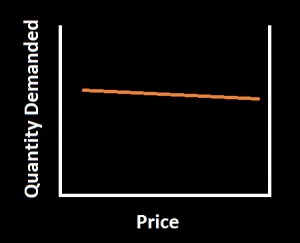
There is, perhaps, some fall in demand. A 96-year-old might decline a quarter million dollar appendectomy. In some cases, there may be more than one treatment for an ailment so that one good or service may be substituted for another. But, in general, demand for health care services, especially the very expensive, life-saving treatments, tends to be highly inelastic. The quantity demanded is affected very little by the price. So, can providers of health care charge whatever they like?
Supply-side salvation?
Not necessarily. There may be some help on the supply side of this market. But, one reason markets are so effective and robust is the interplay of supply and demand. Without both working properly, the market can misallocate. When the supply side of the equation breaks down, for example in the case of a monopoly, we know that even with a healthy demand side, we’ll run into inefficiencies. So, we already have cause to worry. A truly effective market needs both a healthy demand side and supply side.
Switching to the supply side of things, if the price of a good is very high, more people will be willing to supply it. A supplier that overcharges will find herself undercut by a competitor willing to supply the good at a lower price. So, even with highly inelastic demand curves, there’s an equilibrium price at the point where the supply and demand curves meet.
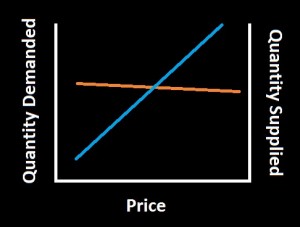
So, it all might work out just fine, as long as actors can’t manipulate the supply curve. Unfortunately, two of the easiest ways to do that are both, of necessity, highly active in health care markets. The first is patents. A patent grants a single company the exclusive right to produce a product for a certain period. A supplier with a patent cannot be undercut by a cheaper competitor. When you are the only supplier of a lifesaving procedure, the market will not place any limit on the price (although public opinion or your own morality might). For this reason, it’s more useful to think about the supply curve for health care research than for particular treatments. If the payout for developing a new drug is very high, more people will be willing to do research toward that end. So, even where patents are applied, there is a functioning supply side curve at work. But in such a market, price signals can take longer to move through the market. When I need medication today, it’s slim comfort to know that the exorbitant price I pay for patent-protected drugs is providing the impetus for a robust market for drug research.
Another common way to move a supply curve is through licensing. Most people who treat you in the hospital are licensed, some of them very licensed, which is wonderful. It comforts me immensely that the person holding the scalpel has undergone years of training and scrutiny. But, the effect of this is to reduce the supply of doctors, nurses and other medical professionals. The FDA’s approval processes provide the same type of scrutiny for medications, equipment and treatments, with the same effect.
I wouldn’t have it any other way, of course, but the effect of this licensing is to shift the supply curve downward, increasing the price of goods. The further the supply is reduced, the higher the price. The inelasticity of the demand curve (and also the supply curve) multiplies this effect.
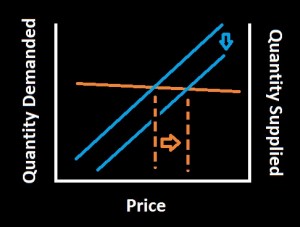
You can see how influence of these licensing processes could be very lucrative for suppliers. Doctors, for the most part, do important work for sincerely good reasons, but putting the AMA in charge of licensing doctors is a lot like asking the fox to guard the hen house. The tendency of almost everyone is to highly value their own work and the incentive for doctors is to limit the supply of doctors, raising their own salaries. Similarly, if pharmaceutical or medical supply companies can delay or scuttle approval for competing drugs and equipment, they also stand to make lots of money.
I’m not for a minute suggesting we do away with licensing of doctors or patents for drugs. Health care markets can’t be effective without these things. But, perhaps it’s a good idea to think hard about the markets for health care rather than blithely assuming the miraculous market will allocate everything just right. Without some advocates for consumers of health care, rising, inelastic demand will push prices out of reach and make life-saving care an unaffordable luxury.
